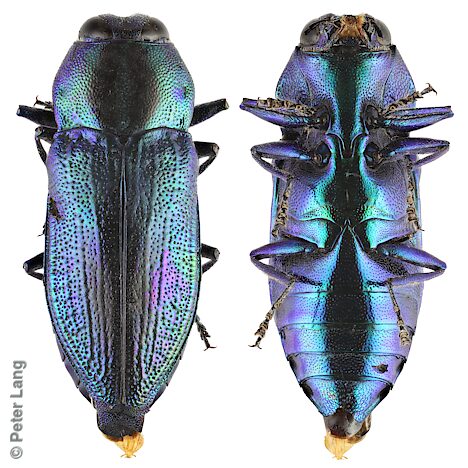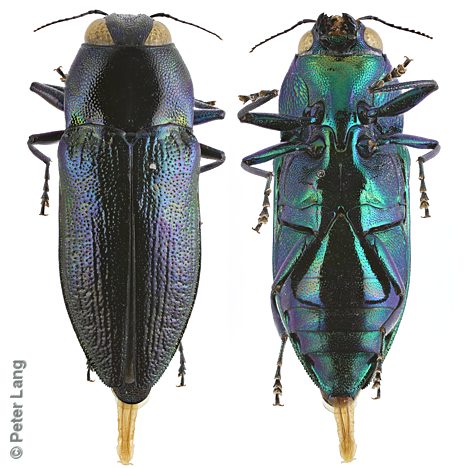

size¹:
×
5.7 mm


| female | ||||||
|---|---|---|---|---|---|---|
| L1 | 14.8 | 13.5 – 16.05 | n = 2 | |||
| L2 | 14.5 | 13.3 – 15.65 | n = 2 | |||
| W | 5.7 | 5.3 – 6 | n = 2 | |||
| Legend | L1 | length from clypeus/frons to elytral apex (mean, range, sample size) |
| L2 | length from anterior of edge of eyes to elytral apex | |
| W | maximum width with elytra fully closed |
A relatively large species with varying degrees of violet, blue and green colouration. Differs from the related S. viridicyanea in its more elongate body shape, with the elytra more tapered, more strongly puncturated, and having a narrower flange on their margins. The pronotum with, or without, a weak to strong fovea on each margin at, or just below, its mid-length, and there may be some form of a weak ledge associated with the fovea. However, the pronotum margins are not strongly or widely flattened towards the posterior corners as in S. viridicyanea. That is a similar, but shorter and broader, species from more tropical areas of eastern Australia with the males distinguished by being green-gold.
In the same paper, Fairmaire 1877a described both Selagis chloriantha, with its holotype from King George Sound in Western Australia, and the related S. viridicyanea, with the (probable) holotype from Rockhampton in Queensland.
The name Selagis viridicyanea was previously misapplied to most SA specimens of S. chloriantha at the SA Museum. One specimen there that does actually match S. viridicyanea was photographed for the SA beetle guide of Matthews 1985 (p. 47, fig. C15 ). However, it is completely without label data and presumably originated from eastern Australia.
Until February 2024, Selagis chloriantha was included on these webpages as 'Selagis sp. Large', and reference was made to features in some forms as indicating possible intergradation between S. chloriantha and S. viridicyanea. This now recognised as being consistent with variation found within S. chloriantha in Western Australia.
| Legend | P.J.Lang collection vouchered records | |
| other private collection or museum specimens, or sightings |
| colour | beetles | sites | SA regions¹ | |
| blue | 1 | 1 | EP |
Goudie 1920 reports taking this species [as Curis viridicyanea] in north-western Victoria 'on the foliage of the Quondong, [Santalum acuminatum, as Fusanus acuminatus], in November'.
Evidence for breeding in mallee Eucalyptus is provided by a specimen at the SA Museum collected by J.G.O. Tepper in 1901. Its handwritten label reads: 'Norwood In block of mallee wood Aug 1901 Tepper [5]?.10.01'. Norwood is a suburb of Adelaide, and presumably it refers to mallee wood transported there from outlying mallee districts, most likely for firewood. The specimen is incomplete, lacking a head and most legs, consistent with it having been extracted dead from wood.
| ¹ Legend | regions | SA State Herbarium regions (map) EA: Eastern, EP: Eyre Peninsula, FR: Flinders Ranges, GT: Gairdner-Torrens, KI: Kangaroo Island, LE: Lake Eyre, MU: Murray, NL: Northern Lofty, NU: Nullarbor, NW: North-Western, SE: South-Eastern, SL: Southern Lofty, YP: Yorke Peninsula |
| size | The ellipse is the correct size when printed, indicative on a desktop screen, and likely to be wrong on a mobile device. |